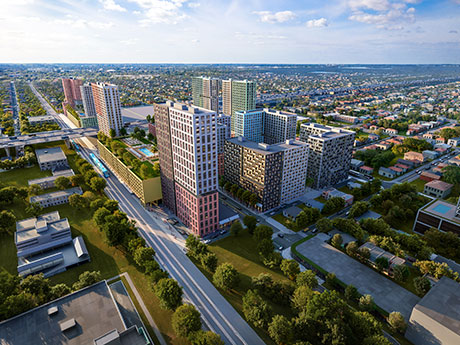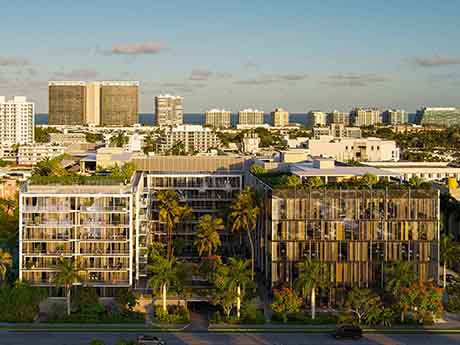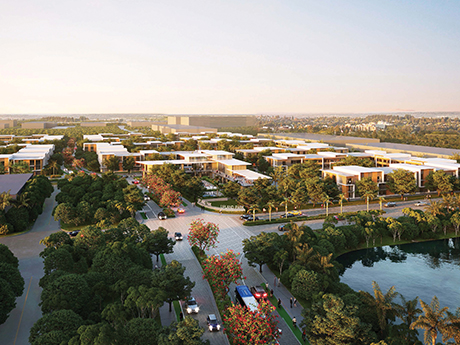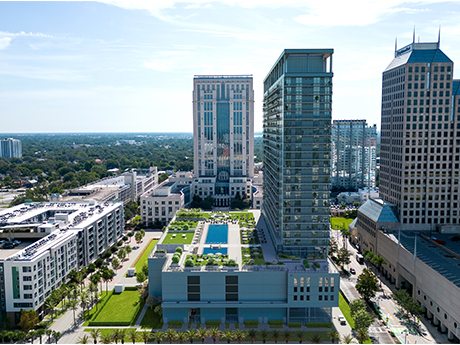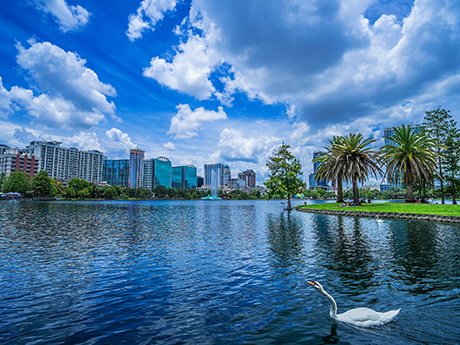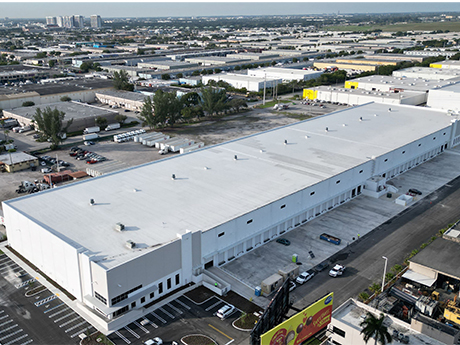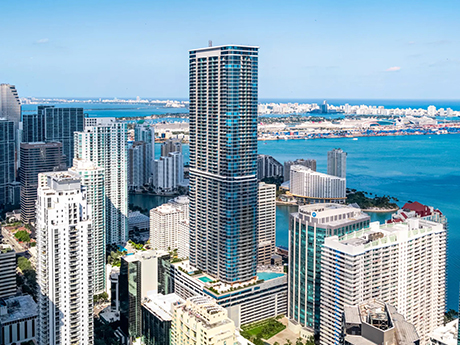This year marks the centennial of several Miami municipalities, including Coral Gables and Hialeah, placing Miami-Dade County in a unique position: looking back on a rich history as a sunseeker’s playground, while charging full speed into a future where it is also a tech hub and financial powerhouse, with some dubbing the city as “Wall Street South.” From the first land rush in the 1920s to the post-pandemic migration surge a century later, Miami’s real estate story includes fascinating characters, iconic architecture, multiple booms and busts and not one but two great railroad eras — all contributing to the city’s allure as a place to live, and where institutional-quality capital is increasingly eager to invest. Population, job momentum Miami has enjoyed one of the strongest multifamily markets in the country for roughly the past decade. A blend of population growth and job creation forms the backbone of Miami’s resilient rental market. Miami-Dade County added over 64,000 net new residents as of July 2024, driven almost entirely by international newcomers. According to the U.S. Census Bureau, the county saw 123,835 international arrivals, offsetting the 67,000 locals who left. Behind that growth is an unprecedented business boom. Lured by Florida’s business-friendly environment …
Market Reports
Over the past five years, the national office market has faced its fair share of challenges: hybrid work reshaping demand, a surge in sublease spaces and rents stagnating in many cities. But Miami’s office market? It’s been a standout performer, and it’s soaring, not just holding its ground. From the onset of the COVID-19 pandemic, Miami began to separate itself from other major metros. While cities across the country struggled to coax tenants back to the office, Miami became a hotspot for companies eager to expand. What began as an influx of interest from financial firms, law practices and tech companies quickly evolved into a significant shift. These weren’t temporary moves — these were long-term leases and major investments. Since 2020, Miami-Dade has absorbed nearly 3 million square feet of office space. Unlike other cities where growth has fluctuated, Miami’s demand has been steady. Even as leasing slowed down nationally in 2023, Miami managed to hold strong. By 2024, leasing activity picked up again, and the first quarter of 2025 saw impressive absorption numbers. A major factor in Miami’s success is its disciplined approach to office development. While other markets overbuilt, leading to high vacancy rates, Miami’s new supply has …
South Florida remains one of the most attractive markets for multifamily investment in the United States, driven by population growth, job creation and limited rental supply. While 2024 saw slower transaction volumes, fundamentals suggest a rebound is coming in 2025. This article explores trends in investment sales, debt capital markets and joint venture (JV) equity, highlighting how strategic structuring and strong relationships are driving activity in today’s selective capital environment. Poised for sales growth Miami’s multifamily market continues to thrive, fueled by population growth, high rental demand and major developments. The city’s job market, with an unemployment rate of just 2.4 percent, is expected to grow by over 18,000 positions in 2025. Corporate expansions — like Citadel, MSC Group, Nvidia, Microsoft and Shopify — have driven demand for luxury rentals, while vacancy rates remain under 5 percent. With home prices rising over 70 percent in the past five years and mortgage rates more than doubling, homeownership is out of reach for many. As a result, demand for luxury rentals remains strong, especially in suburban areas where transit-oriented developments are emerging. One standout is Terra’s $1 billion Upland Park in West Miami-Dade County. In partnership with the county, the project includes …
FloridaGeorgiaMarket ReportsNorth CarolinaSouth CarolinaSoutheastSoutheast Market ReportsStudent Housing
Universities, Student Housing Properties in Southeast Contend with Hurricane Helene
by John Nelson
Hurricane Helene made landfall in Northwestern Florida on Thursday, Sept. 26, after being upgraded to a major Category 3 storm that afternoon. Widespread damage across a number of Southeastern states followed in its wake, with many areas experiencing flooding, downed trees, power outages and road closures. At least 175 people have died across six states, according to reports by CNN and The New York Times, and officials fear that the death toll is likely to rise with many remaining missing. Hundreds of roads remain closed across the Southeast — especially in Western North Carolina and East Tennessee, which were hit particularly hard by the hurricane — hampering the delivery of supplies, and more than 2 million customers remain without power. Student Housing Business reached out to universities, owners, operators and students across the Southeast to check in on how they fared during the storm and their experience in the aftermath. Owners, Operators Weigh In Denver-based Cardinal Group tracked its communities in Alabama, Arkansas, Florida, Georgia, Kentucky, North Carolina, South Carolina, Tennessee, Virginia and West Virginia through Hurricane Helene. “Of those communities, four experienced power outages and several had minor roof leaks and flooding, with the largest impact felt in Asheville and Boone, North Carolina,” says Jenn Cassidy, president of property operations …
Orlando’s multifamily market has experienced softened conditions lately due to a record amount of new supply being built, as well as economic challenges impacting commercial real estate as a whole. Yet, green shoots have emerged as insurance costs continue to ease and interest rates remain steady with downward pressure. Both overall sentiment and renter demand have steadily improved as well. Properties in the multifamily space seeing the most interest these days are those that are high-quality and well-located. Two key multifamily sale transactions that occurred in the second quarter of 2024 were in the Southwest Orlando submarket. This includes the 424-unit Osprey Links at Hunter’s Creek property that sold for $100.6 million, which marked Orlando’s largest multifamily sale this year, and the 296-unit Sonceto Apartments property that sold for $71 million. Investors are flooding back into the market with increasingly more aggressive offers and heightened competition as a result of the still limited available multifamily inventory and notion that supply levels have peaked. However, additional supply will still enter the market in the years to come as developers maintain a positive outlook on Orlando with just over 2,000 units across six buildings delivered by the end of the second quarter …
The commercial real estate market, particularly in the retail leasing sector, has been navigating a complex and dynamic landscape over the past few years. With a blend of high demand, limited supply and fluctuating economic variables, the Orlando market presents both challenges and opportunities for developers, landlords and tenants alike. High demand, limited supply One of the most prominent trends in the Orlando retail leasing market is the high demand for quality retail spaces. Retailers are eager to establish and expand their presence in this thriving market, driven by a growing population and increasing consumer spending. However, the inventory of quality existing retail bays is incredibly scarce. This scarcity has created a competitive environment where desirable locations are quickly snapped up, often at premium prices. The supply-demand imbalance has pushed developers to sharpen their pencils and critically analyze the feasibility of new projects. Despite the strong demand, many deals struggle to pencil out due to the high costs of construction materials and labor. These costs have remained elevated, making it challenging for developers to achieve a satisfactory return on investment. As a result, some projects are delayed or shelved, further constraining the supply of retail space. Housing spurs development The …
Orlando’s industrial market has enjoyed consistently low vacancy, robust new development and significant rent growth year after year since the onset of the pandemic. While fundamentals remain strong, project deliveries and changing size preferences for leased space have caused a shift in activity. From an economic perspective, Orlando is well-positioned. The unemployment rate has decreased by 30 basis points since first-quarter 2024, reaching 2.9 percent, notably lower than the national average of 4.3 percent. Over the past year, nonfarm employment has grown by 1.4 percent with construction employment seeing a significant increase of 2.9 percent during the same period. Small to mid-sized spaces For the past 20 consecutive quarters, Orlando has maintained positive net absorption. Small bay and other tenants under 200,000 square feet have dominated leasing activity, while demand for spaces over 200,000 square feet has significantly slowed. As a result, year-to-date absorption is just over 800,000 square feet, representing a 40.8 percent decrease compared to 2023’s midyear total and the lowest midyear total since 2020. This slowdown in absorption is accompanied by a rise in vacancy rates, which have increased by 1 percent since last year and 3 percent since 2022. ATR Commercial Flooring took 150,600 square feet …
In the Tampa Bay area, industrial activity remains strong to this point in 2024. According to market research from Colliers, the industrial market closed the first quarter of the year with a vacancy rate below 6 percent. From 2019 to 2022, leasing activity increased, with some fluctuations between quarters. Meanwhile, 2023 saw more than 12.2 million square feet of renewals, expansions and new leases in the greater Tampa Bay area. The data backs up what we are seeing as brokers – a high-demand market with positive net absorption. With that, there are also several trends that have emerged in 2024. 1.) A generally competitive but well-balanced market. While the Tampa Bay industrial market is competitive, it’s overall well-balanced — favoring neither the landlord nor tenant in its current state (of course, dependent on size and submarket). This balance can be attributed to a slowdown in new construction, high occupancy rates, rising rental rates and continued strong demand. However, rates are not rising as quickly as they have been in the past few years, and tenants are selective about space and want to see several options and thoroughly survey the market before executing a deal. There are also pockets of the …
By Ben Eisenberg of Transwestern In 2023 and continuing into 2024, Miami’s industrial sector experienced moderate growth due to reduced lease turnover and despite accelerating interest rates and economic uncertainty. However, the market’s strong industrial fundamentals and international connectivity via Miami International Airport and PortMiami continue to demonstrate its enduring strength and resilience. Miami’s industrial market is powered by freight, logistics and e-commerce demand, along with traditional distribution, service and light assembly. The region continues to experience steady population growth that drives sustainable consumption of goods and services and, ultimately, the need for warehouse space. Accounting for nearly 27 percent of Florida’s overall population, Miami was home to more than 6.2 million people at the end of 2023 and is projected to grow to 6.3 million this year. The region’s population has expanded by nearly 7.6 percent over the past 10 years. Increased migration to the Sun Belt has boosted wealth, disposable income and consumption, making Miami one of the nation’s wealthiest metro areas, with some of the highest average home values. In the first quarter of 2024, Miami’s unemployment rate reached a record low of 1.5 percent and has remained below 2 percent since the fourth-quarter 2022. The region’s …
Miami’s multifamily sector was on fire from the end of 2020 through the beginning of 2023 as the market received a wave of newcomers, primarily from affluent Northeastern and Western states. During the height of the pandemic, roughly $1 out of every $6 in income that moved nationwide relocated to Florida, more than any other state. And Miami-Dade County saw the second highest inflows of any county in the country behind only Palm Beach, two counties to the north of Miami-Dade. This influx resulted in tremendous rent growth, booming new development and record-setting sales. The period also marked dozens of corporate expansions and relocations to the area and a consistent sub-3 percent unemployment rate dating back to August 2022, which is below today’s 3.8 percent national rate. Since then, things have slowed down, though the epic in-migration of wealth has made a permanent impact. Miami’s multifamily fundamentals stand out as a beacon of resilience amid supply challenges across the Sun Belt. Infill rents have remained flat since 2022, notching slight increases in 2024, and occupancy has faltered only slightly. This is rarely celebrated, but in this case, it represents Miami’s unique strength. Demand also emerged for a higher caliber of …
Newer Posts


